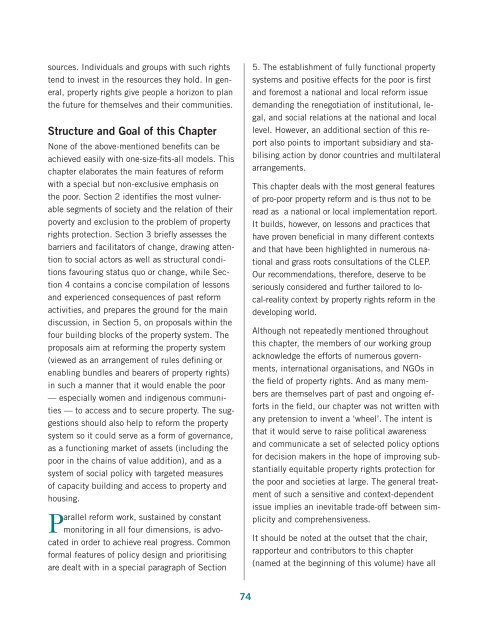Download the file - United Nations Rule of Law
Download the file - United Nations Rule of Law
Download the file - United Nations Rule of Law
Create successful ePaper yourself
Turn your PDF publications into a flip-book with our unique Google optimized e-Paper software.
sources. Individuals and groups with such rightstend to invest in <strong>the</strong> resources <strong>the</strong>y hold. In general,property rights give people a horizon to plan<strong>the</strong> future for <strong>the</strong>mselves and <strong>the</strong>ir communities.Structure and Goal <strong>of</strong> this ChapterNone <strong>of</strong> <strong>the</strong> above-mentioned benefits can beachieved easily with one-size-fits-all models. Thischapter elaborates <strong>the</strong> main features <strong>of</strong> reformwith a special but non-exclusive emphasis on<strong>the</strong> poor. Section 2 identifies <strong>the</strong> most vulnerablesegments <strong>of</strong> society and <strong>the</strong> relation <strong>of</strong> <strong>the</strong>irpoverty and exclusion to <strong>the</strong> problem <strong>of</strong> propertyrights protection. Section 3 briefly assesses <strong>the</strong>barriers and facilitators <strong>of</strong> change, drawing attentionto social actors as well as structural conditionsfavouring status quo or change, while Section4 contains a concise compilation <strong>of</strong> lessonsand experienced consequences <strong>of</strong> past reformactivities, and prepares <strong>the</strong> ground for <strong>the</strong> maindiscussion, in Section 5, on proposals within <strong>the</strong>four building blocks <strong>of</strong> <strong>the</strong> property system. Theproposals aim at reforming <strong>the</strong> property system(viewed as an arrangement <strong>of</strong> rules defining orenabling bundles and bearers <strong>of</strong> property rights)in such a manner that it would enable <strong>the</strong> poor— especially women and indigenous communities— to access and to secure property. The suggestionsshould also help to reform <strong>the</strong> propertysystem so it could serve as a form <strong>of</strong> governance,as a functioning market <strong>of</strong> assets (including <strong>the</strong>poor in <strong>the</strong> chains <strong>of</strong> value addition), and as asystem <strong>of</strong> social policy with targeted measures<strong>of</strong> capacity building and access to property andhousing.Parallel reform work, sustained by constantmonitoring in all four dimensions, is advocatedin order to achieve real progress. Commonformal features <strong>of</strong> policy design and prioritisingare dealt with in a special paragraph <strong>of</strong> Section5. The establishment <strong>of</strong> fully functional propertysystems and positive effects for <strong>the</strong> poor is firstand foremost a national and local reform issuedemanding <strong>the</strong> renegotiation <strong>of</strong> institutional, legal,and social relations at <strong>the</strong> national and locallevel. However, an additional section <strong>of</strong> this reportalso points to important subsidiary and stabilisingaction by donor countries and multilateralarrangements.This chapter deals with <strong>the</strong> most general features<strong>of</strong> pro-poor property reform and is thus not to beread as a national or local implementation report.It builds, however, on lessons and practices thathave proven beneficial in many different contextsand that have been highlighted in numerous nationaland grass roots consultations <strong>of</strong> <strong>the</strong> CLEP.Our recommendations, <strong>the</strong>refore, deserve to beseriously considered and fur<strong>the</strong>r tailored to local-realitycontext by property rights reform in <strong>the</strong>developing world.Although not repeatedly mentioned throughoutthis chapter, <strong>the</strong> members <strong>of</strong> our working groupacknowledge <strong>the</strong> efforts <strong>of</strong> numerous governments,international organisations, and NGOs in<strong>the</strong> field <strong>of</strong> property rights. And as many membersare <strong>the</strong>mselves part <strong>of</strong> past and ongoing effortsin <strong>the</strong> field, our chapter was not written withany pretension to invent a ‘wheel’. The intent isthat it would serve to raise political awarenessand communicate a set <strong>of</strong> selected policy optionsfor decision makers in <strong>the</strong> hope <strong>of</strong> improving substantiallyequitable property rights protection for<strong>the</strong> poor and societies at large. The general treatment<strong>of</strong> such a sensitive and context-dependentissue implies an inevitable trade-<strong>of</strong>f between simplicityand comprehensiveness.It should be noted at <strong>the</strong> outset that <strong>the</strong> chair,rapporteur and contributors to this chapter(named at <strong>the</strong> beginning <strong>of</strong> this volume) have all74
















